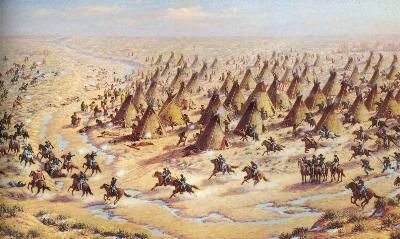| Governor
John Evans of Colorado Territory sought to open up the Cheyenne and
Arapaho hunting grounds to white development. The tribes, however,
refused to sell their lands and settle on reservations. Evans decided to
call out volunteer militiamen under Colonel
John Chivington to quell the mounting violence. Evans used isolated incidents of
violence as a pretext to order troops into the field under the
ambitious, Indian-hating military commander Colonel
Chivington. Though John Chivington had once belonged to the clergy, his
compassion for his fellow man didn't extend to the Indians.
In the spring of 1864, while
the Cival War raged in the east, Chivington launched a campaign of
violence against the Cheyenne and their allies, his troops attacking any
and all Indians and razing their villages. The Cheyennes, joined by
neighboring Arapahos, Sioux, Comanches, and Kiowas in both Colorado and
Kansas, went on the defensive warpath. Evans and Chivington reinforced
their militia, raising the Third Colorado Calvary of short-term
volunteers who referred to themselves as "Hundred Dazers".
After a summer of scattered small raids and clashes, white and Indian representatives met at Camp Weld outside of Denver on September 28. No
treaties were signed, but the Indians believed that by reporting and
camping near army posts, they would be declaring peace and accepting
sanctuary.
Black Kettle was a peace-seeking
chief of a band of some 600 Southern Cheyennes and Arapahos that
followed the buffalo along the Arkansas River of Colorado and Kansas.
They reported to Fort Lyon and then camped on Sand Creek about 40 miles
north.
Shortly afterward, Chivington led
a force of about 700 men into Fort Lyon, and gave the garrison notice of
his plans for an attack on the Indian encampment. Although he was
informed that BlackKettle has already surrendered, Chivington pressed
on with what he considered the perfect opportunity to further the cause
for Indian extinction. On the morning of November 29, he led his troops,
many of them drinking heavily, to Sand Creek and positioned them, along
with their four howitzers, around the Indian village.
Black Kettle, ever trusting, ran up President Lincoln's American flag and a white flag of truce on a large lodge pole in front of his tipi to reassure his people.
In response,
Chivington raised his arm for the attack.
The main body of Indians fled towards the dry creek bed frantically digging pits in its sandy banks for protection. Those warriors who had been able to grab their weapons engaged in a desperate rear-guard action, killing 8 and wounding 38 of their attackers. White Antelope died in front of his tipi wearing Lincoln's peace medal, his arms folded, singing his death song, "nothing live long, except the earth and the mountains."
Black Kettle and his wife followed the others up the stream bed, his wife being shot in the back and left for dead. The troops kept up their indiscriminate assault for most of the day and many atrocities were committed. One Lieutenant killing and scalping 3 women and 5 children who had surrendered and were screaming for mercy. Finally breaking off their attack they returned to the camp killing all the wounded they could find before mutilating and scalping the dead, including pregnant women, children and babies. They then plundered the tipi's and divided up the Indians horse herd before leaving.

Sand Creek Massacre
The colonel was as thourough as he
was heartless. An interpreter living in the village testified,
"THEY WERE SCALPED, THEIR BRAINS KNOCKED OUT; THE MEN USED THEIR
KNIVES, RIPPED OPEN WOMEN, CLUBBED LITTLE CHILDREN, KNOCKED THEM IN THE
HEAD WITH THEIR RIFLE BUTTS, BEAT THEIR BRAINS OUT, MUTILATED THEIR
BODIES IN EVERY SENSE OF THE WORD."
By the end of the one-sided
battle as many as 200 Indians, more than half women and children, had
been killed and mutilated (some sources put the figure as high as 500). The vast majority of victims were however women and children. Black Kettle's wife although shot 9 times somehow managed to survived the attack. The survivors, over half of whom were wounded, sought refuge in the camp of the Cheyenne Dog Warriors (who had remained opposed to the 'peace' treaty) at Smokey Hill River.
The Colorado volunteers returned to Denver, exhibiting their scalps, to receive a hero's welcome.
Chivington later appeared on a Denver stage where he regaled
delighted audiences with his war stories and displayed 100 Indian
scalps, including the pubic hairs of women. Chivington was later denounced in
a congressional investigation and forced to resign. When asked at the
military inquiry why children had been killed, one of the soldiers
quoted Chivington as saying, "NITS
MAKE LICE." Yet the
after-the-fact reprimand of the colonel meant nothing to the Indians.
As word of the massacre spread
among them via refugees, Indians of the southern and northern plains
stiffened in their resolve to resist white encroachment. An avenging
wildfire swept the land and peace returned only after a quarter of a
century.
|
